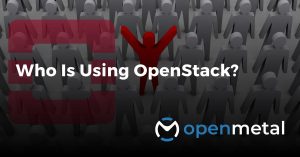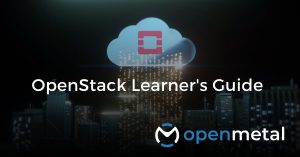In this blog:
- What Is OpenStack?
- How Was OpenStack Founded?
- What Can You Use OpenStack For?
- How Does OpenStack Work?
- What Are The Pros Of Using OpenStack?
- What Are The Cons Of Using OpenStack?
- What Are The Benefits Of An On-Demand Private Cloud Hosted On OpenStack?
- Is OpenStack The Right Environment For Your Workloads?
- How To Get Started On OpenStack?
OpenStack is one of the most popular open-source software solutions for cloud infrastructure. If you are tired of unpredictable public cloud bills or want more control over your infrastructure, you may be considering migrating workloads to an OpenStack cloud. Private OpenStack clouds are increasing in popularity as organizations seek to reduce cloud costs and have root level access to optimize their infrastructure for their workloads. This blog will cover everything you need to know about OpenStack and provide you with a step by step guide on how to get started on OpenStack.
What is OpenStack?
OpenStack is a collection of open source software tools for creating and managing cloud infrastructure. OpenStack was designed to provide flexibility and scalability when deploying and managing cloud resources. This makes OpenStack suitable for a variety of use cases from small private clouds to large-scale public cloud environments. Additionally because the code for OpenStack projects are open source, users are able to make root level configurations to secure, optimize, customize and integrate their cloud. We’ll go into more details about these later. Let’s first look at how it all started.
How Was OpenStack Founded?

OpenStack was founded in 2010 through a collaborative effort between NASA and RackSpace. In my view, NASA’s pivotal role in the inception of this open-source technology not only lends it credibility but also adds an extra layer of fascination.
Currently, OpenStack is governed by the Open Infrastructure Foundation which has over 110,000 members in 187 countries. The objective of the Open Infrastructure Foundation is to build open source communities that write software that runs in production. 100,000+ members working to continuously test and improve OpenStack for over a decade allowed this open source software to not only evolve into something that is truly reliable, but made it feasible for OpenStack to be updated consistently to keep up with modern needs.
What Can You Use OpenStack For?
A virtual machine deployed with OpenStack can be implemented for a multitude of use cases. This includes software-as-a-service delivery, container deployments, heterogeneous compute, and web hosting.
OpenStack is currently used by organizations such as Nike, Verizon, Bloomberg, T-Mobile, Walmart, Target, Volkswagen, Rakuten, Progressive, Overstock.com, and many more. With many key organizations from various industries putting their workloads on OpenStack clouds, it’s clear that OpenStack is a safe, dependable, and financially wise choice for organizations.
How Does OpenStack Work?
OpenStack is a platform composed of several independent components often referred to as projects. These components interoperate with each other through Application Programming Interface (API). These components are complementary, but do not depend on all other components to function properly. This grants you the ability to build your cloud with only the components you need.
This feature is what attracts so many users to OpenStack. You can build your cloud with the components you need for your workload and not waste hardware resources on additional components which are not necessary for the functionality you require in your cloud. This is something you cannot get with public clouds that do not give you access to configuration at the root level. Let’s dig deeper into the benefits of choosing OpenStack for your cloud needs.
Please note OpenMetal’s On-Demand OpenStack clouds provided by OpenMetal have been tweaked and applied to a variety of common use cases.
But before we commit to OpenStack, let’s explore the pros and cons of using OpenStack.
What Are The Pros Of Using OpenStack?
When you consider the list of major industry players using OpenStack, it is not surprising that there are many pros to using OpenStack. These include:
- Easy Scalability: With OpenStack, you can scale your cloud up or down at a bare metal level. This is beneficial if you are in an industry that has peaks or downtimes. You will have access to additional resources when you need them and you only pay for them when you use them. This allows you to keep up with your customers’ demands without exceeding your budget.
- Affordable: Because OpenStack is open source, the source code is available freely for public use. It was released as open source under the Apache 2.0 license. However, you will still have hardware costs unless you use an OpenStack vendor.
- Easy Automation: OpenStack has tools that can make cloud management easier. OpenStack also has its own API which allows other programs to tap into it. Developers can create their own solutions to automate tasks and share them with the OpenStack community. With more than a decade of contributions from the open source community, there are various automation tools available.
- Reliable: The OpenStack software has been improved over for over a decade. It gives you a tried and true approach. Any use you can think of for OpenStack has probably been thought of, tried, and tested.
- Fast Development: If a new OpenStack feature is being developed, it can be quickly worked on by a team of expert developers from around the world. This allows OpenStack to keep up with the fast-paced tech world.
- Vendor-neutral: With OpenStack, you will never have to deal with vendor lock-in because it is open source! If you do opt to use an OpenStack provider, it is easy to switch between vendors.
Now, you may have a clear understanding of why so many organizations turn to OpenStack. But before jumping headfirst into OpenStack, let’s consider some of the cons.
What Are The Cons Of Using OpenStack?
- Manual Installation: OpenStack is a suite of projects and each of those applications needs to be configured to your needs. You will need an OpenStack expert or team of experts depending on the size of your project. Additionally, you will need expensive hardware and your engineers’ time will be allocated to setting up your cloud for weeks. This is usually the deal breaker for many small to medium sized businesses that need all hands on deck. But notice I specified manual installation, there are ways to get OpenStack installed without doing it yourself that I will address later on in this post.
- Consistency: As the open source community continues to contribute, the OpenStack component suite is always in flux as new components are added and others are depreciated.
- Support: OpenStack is not owned or directed by any one vendor or team. So, no one is responsible for providing support on your uniquely configured cloud.
You can avoid many of these cons by opting to use an OpenStack vendor such as OpenMetal. OpenMetal has a team of experts with a range of complementary skills. Our team can set up and configure your cloud so it’s optimized for your use case. And with OpenMetal, you also have support from our team of skilled engineers. OpenMetal can provide you with a cloud and manage the hardware in our data centers – often referred to as managed private cloud. To learn more about these options, you can inquire with an OpenMetal Consultant.
What Are The Benefits Of An On-Demand Private Cloud Hosted On OpenStack?
OpenMetal provides you with a production-ready hosted private cloud in less than 45 seconds. OpenMetal clouds come with our OpenStack backed by Ceph storage and all core services we recommend for efficient day 2 operations.
OpenMetal’s On-Demand OpenStack clouds begin with a Private Cloud Core (PCC), consisting of a hyper-converged cluster of three servers tailored to your hardware preferences. The PCC is established through the utilization of Kolla-Ansible and Ceph-Ansible, offering you the flexibility to expand and tailor your cloud environment since you have root-level control. OpenMetal Private Cloud Cores (PCCs) are versatile, and suitable for both public cloud and private cloud workloads. This highlights the versatility and capability of the OpenStack cloud platform.
Additionally, we do not charge by CPU, GPU, RAM, or storage usage. With OpenMetal, you pay for a block of physical hardware resources (with defined CPU/RAM/Storage or GPU, etc) and you can use them as much as you want as long as you are within the limitation of your server’s hardware resources. Each cloud has the ability to host 10s – 1000s of virtual machines (VM) and you determine how much resource to allocate to each VM. You can spin up and down VMs as you need with no impact on your bill.
Customers switching to OpenMetal from the public cloud have seen their cloud bills reduce by 50%. You can learn more about our customers and their experience migrating workloads to OpenMetal via our case studies.
Is OpenStack The Right Environment For Your Workloads?
The only way you can be sure that OpenStack is the right environment to run your workloads is by running workloads in OpenStack. And you can do so at no cost to yourself. OpenMetal allows individuals and organizations to test our clouds to learn more about OpenStack and see if the environment is the right fit for you without having to dedicate time and resources to build your own OpenStack cloud. You can test your workloads in OpenStack by signing up for a free trial. Be sure to create an organizational account to get a POC which is tailored to organizations seeking to test workloads in OpenStack.
How To Get Started On OpenStack?
Ready to get started on OpenStack? Luckily for you, I’m not a fan of cliffhangers so I won’t make you wait until my next blog post to know what’s the next step. I’m a big believer in learning by doing and OpenMetal provides you with all the resources you need to get started on OpenStack now. Request a trial and follow along with our Operator’s Manual.
You can also access our complete library of OpenStack training resources here. It includes: guides, tutorial videos by FreeCodeCamp and LearnLinuxTv, and Blogs.
More on the OpenMetal Blog…
Are you ready to take charge of your OpenStack training? Look no further! Dive into this treasure trove of knowledge, gain valuable experience, and pave your way to becoming an OpenStack expert….Read More

Alternative Clouds Blurring The Lines Between Public and Private Clouds
This blog discusses the rising costs and lack of control in public cloud services and explores the alternative solution of OpenMetal’s On-Demand …Read More

It may be surprising to see large scale OpenStack use cases such as Walmart or China Mobile, or use cases in organizations like NASA who have stringent security regulations, but the ability of organizations to fine …Read More
Test Drive
For eligible organizations, individuals, and Open Source Partners, Private Cloud Cores are free to trial. Apply today to qualify.
Subscribe
Join our community! Subscribe to our newsletter to get the latest company news, product releases, updates from partners, and more.



































